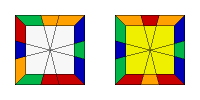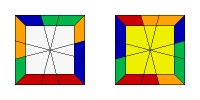blade740
Mack Daddy
Here's a trick I've been working on for the past few days. You should already know how to solve square-1 (preferrably with a vandenbergh-style method rather than a LBL method). It doesn't work on every solve, but it's good for turning mediocre solves into good ones. I'm currently using this kinda like some fridrich solvers use COLL: I use it for an easier solve when it's convenient, and don't even try when it's not.
I discovered that several PLLs on square-1 (and on 3x3, though that's not as useful) can be solved with 2 CP algs (which are always combinations of N and J).
I've done H and U this way for a long time, but that was only to avoid learning EP algs. Now I'm using it for something a bit more useful: 1-look permutation of both layers, in 2 algs.

The pink boxes show where CP algs should be applied. N's can be executed from any angle, but have to be adjusted correctly. J's (mostly) have only one way to be placed. (Not all, though. Permutations like Y and T can be done mirrored from either side)
Besides those, you can also do J, N, and solved. All you have to do for those is do any CP algorithm (with proper alignment) that DOESN'T solve the permutation. This is simply because J/solved is a much worse algorithm than J/J on square-1. Also, H is done with an N from ANY angle and ANY alignment.
The trick is to do BOTH layers at the same time. For example:

Looking at the chart, T has to be solved with a J, and H with an N. So to setup, I would do (-3,0) to setup the J and then do the J/N corner permutation (/(0,-3)/(0,3)/(0,-3)/(0,3)/)
This leaves you with this:

Which, as you should know, is easily solved by doing (4,1) then doing the same J/N algorithm.
After practice you should be able to recognize if the permutation can be solved with this technique, and know exactly what the second permutation will be beforehand, and be able to fingertrick the two short CP algs into one continuous motion.
Another interesting idea is this: what about a method that involves ALWAYS doing full permutation, rather than corners then edges. I'm fairly sure (though not certain) that all even permutations can be solved in 3 algorithms or less. With 3 different parity fixes (parity in U, parity in D, and "parity in both layers" which is really just any short algorithm (opp/opp EP comes to mind) that changes both layers' parity. It would be relatively fast, since CP algs used in this method are very short (especially compared to some of the worse EP algs), and instead of learning several algs, you'd just have to learn which CP algorithm to apply to each case, and in which orientation (and, to be able to lookahead, which algorithm it would lead to next). I think "J, 4, J -1 N" is MUCH easier to memorize than a full-length algorithm, and with practice you could execute VERY quickly.
So, any questions? Comments? Is there a case you don't understand? Do I need more examples? Feel free to ask.
I discovered that several PLLs on square-1 (and on 3x3, though that's not as useful) can be solved with 2 CP algs (which are always combinations of N and J).
I've done H and U this way for a long time, but that was only to avoid learning EP algs. Now I'm using it for something a bit more useful: 1-look permutation of both layers, in 2 algs.

The pink boxes show where CP algs should be applied. N's can be executed from any angle, but have to be adjusted correctly. J's (mostly) have only one way to be placed. (Not all, though. Permutations like Y and T can be done mirrored from either side)
Besides those, you can also do J, N, and solved. All you have to do for those is do any CP algorithm (with proper alignment) that DOESN'T solve the permutation. This is simply because J/solved is a much worse algorithm than J/J on square-1. Also, H is done with an N from ANY angle and ANY alignment.
The trick is to do BOTH layers at the same time. For example:
Looking at the chart, T has to be solved with a J, and H with an N. So to setup, I would do (-3,0) to setup the J and then do the J/N corner permutation (/(0,-3)/(0,3)/(0,-3)/(0,3)/)
This leaves you with this:
Which, as you should know, is easily solved by doing (4,1) then doing the same J/N algorithm.
After practice you should be able to recognize if the permutation can be solved with this technique, and know exactly what the second permutation will be beforehand, and be able to fingertrick the two short CP algs into one continuous motion.
Another interesting idea is this: what about a method that involves ALWAYS doing full permutation, rather than corners then edges. I'm fairly sure (though not certain) that all even permutations can be solved in 3 algorithms or less. With 3 different parity fixes (parity in U, parity in D, and "parity in both layers" which is really just any short algorithm (opp/opp EP comes to mind) that changes both layers' parity. It would be relatively fast, since CP algs used in this method are very short (especially compared to some of the worse EP algs), and instead of learning several algs, you'd just have to learn which CP algorithm to apply to each case, and in which orientation (and, to be able to lookahead, which algorithm it would lead to next). I think "J, 4, J -1 N" is MUCH easier to memorize than a full-length algorithm, and with practice you could execute VERY quickly.
So, any questions? Comments? Is there a case you don't understand? Do I need more examples? Feel free to ask.
Last edited:
